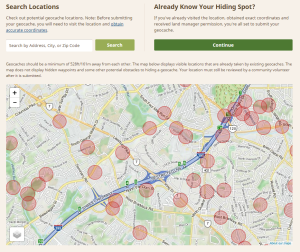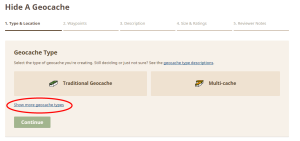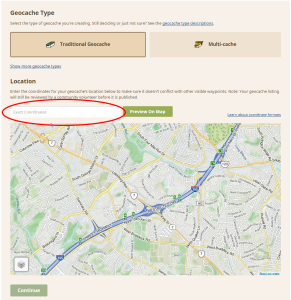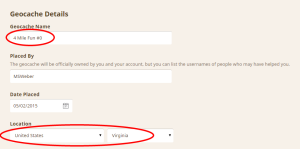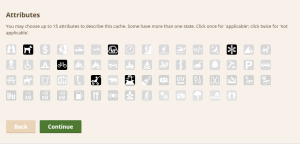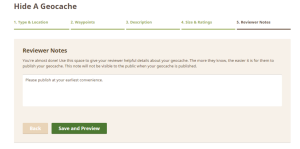It doesn’t take long before a new Geocacher realizes that they can hide a cache for others to find. In my opinion, the first step is for that Geocacher to wait until they have found at least 20 caches. Why, you might ask. Experience. Hiding a Geocache is a huge responsibility. So now you’re thinking, I want to hide a cache, what do I do? Cachers must take many factors into account when placing a container. Here is a partial list:
- Does the container placement abide by the caching database website’s guidelines?
- Is the container placed with permission?
- Could this pose a perceived threat to the community?
- Will this impact the environment?
- Could the placement present a physical danger to cacher’s trying to find it?
- Is the cache type selected appropriate for this cache?
- Will people searching for the container cause harm to wildlife or landscape?
- Does the location of the cache interfere with the cache density rule of 528 feet in all directions (pertains to physical stages)?
- Can the Cache Owner (CO) maintain the cache within a reasonable amount of time?
- Is the cache placed so that it is on a long term basis?
So let’s assume that you have found over 20 caches, have read the list above and still would like to hide a cache. What do you do?
- Go to the website (You can’t hide a cache from the app) of the database where you wish to place the cache (OpenCaching.US, Geocaching.com, etc.) and thoroughly read all of their guidelines.
- Open the online form and start the process (For our example we will use Geocaching.com’s form since we will be placing a cache with their database.)
- These instructions assume you have
picked your really cool cache location, so click on CONTINUE under “Already Know Your Hiding Spot?”
- Select the Geocache Type. If you don’t see the type you want, click on “Show more geocache types”
- Type in ACCURATE coordinates, click PREVIEW ON MAP and make sure that the coordinates you typed in are where you want the cache
- Click CONTINUE
- Enter additional waypoints if you want to show where to Park, the location of the Trailhead, or an orienting Reference Point, otherwise click on CONTINUE
-
Fill in the Cache Name. The Cache Placed By field can be anything you want (i.e. more than one cacher’s name or a team name).
- Adjust the Date Placed if needed.
- Enter the Country and/or State/Province
- The SUMMARY section is limited to 500 characters
- The Description can be as long as you want
- The Background Image and Hint are optional
- One of the most important parts of this page is the “Who can see this geocache?”
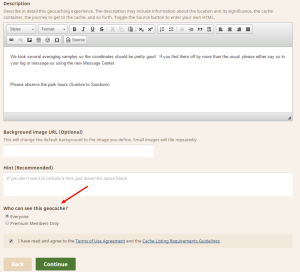 question. If you have a creative cache container that is one of a kind or is high-maintenance you should choose the Premium Member option (Since Premium Members pay to access additional features, they are a bit more “conscientious” when it comes to taking care of containers.
question. If you have a creative cache container that is one of a kind or is high-maintenance you should choose the Premium Member option (Since Premium Members pay to access additional features, they are a bit more “conscientious” when it comes to taking care of containers. - Read and agree to the Terms of Use Agreement and Cache Listing Requirements and Guidelines.
- Click Continue
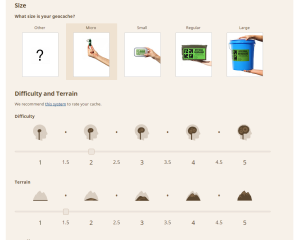
- Select the Size of your container or choose Other if you prefer to keep it a secret
- The Difficulty and Terrain selections are an important part of your cache listing. These selections will define crucial parameters about the caching experience you want to give to other Geocachers. Use your experiences as a FINDER to determine these values. Remember, as the Hider you already know where the cache is, what the container looks like, etc. Also keep in mind ALL the terrain obstacles (water, thorns, hazardous conditions, etc.) that finders will encounter, as well as path/trail/street conditions. These settings can be changed later if you need to tweak them.
- The bottom part of this page allows you to select other parameters about your cache. Note: If you click on an attribute it will be shown as present at your cache. If you click on the same attribute a second time, it will show as not being present at your cache. These settings can be changed later on if conditions change at your cache location.
- Click on CONTINUE and you will be presented with the Reviewer Notes box. This is where you describe in detail about how your cache is hidden and what the container is. You can include anything you want to pass along to the Reviewer here such as “Do NOT publish until Christmas Day” or “I have permission to place a cache here by the property owner”. You MUST type something in here.
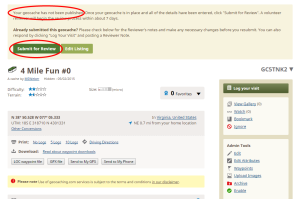
- The next screen you will see is your cache listing. There are two very important items to note. The first is the sentence that reads “Your geocache has not been published”. This is a pausing point so that you can make sure that everything on the listing is the way you want it. When you have finished reviewing your work, then click on the second important item on the page “Submit For Review”
- That’s it!! You have successfully submitted your cache to the Reviewer for publishing to the caching community. Thank you for contributing to the available caches to be found!!!

Your responsibility as a Cache Owner has just started. There seems to be a trend (at least where we live) where people are just not taking care of their containers even with prodding from the caching community with logs that beg for maintenance. Please visit your caches often and keep them going for future cachers.

